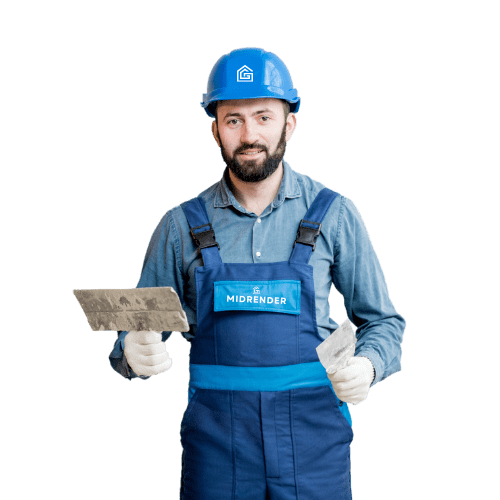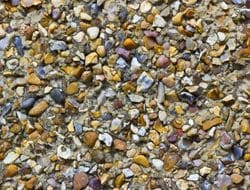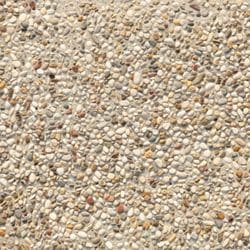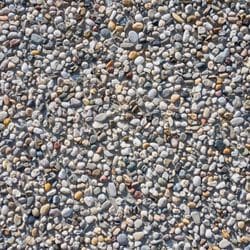
Pebbledash, also known as Roughcast, is a coarse plaster surface applied to the exterior walls of buildings. It is made of lime and sometimes cements combined with sand, small gravel, and frequently pebbles or shells. After the components have been connected to form a slurry, they are distributed around the working surface using a trowel or a scoop. The goal is to keep an even spread devoid of lumps, ridges, or runs and to ensure that none of the backdrops is overlooked. Pebble dashing puts the stones on top of the mixture, whereas roughcasting folds the rocks into the mix.
It is also possible to explain that it is an exterior wall finish constructed of mortar against which small stones have been hurled and pressed in while the mortar was still wet.
Even if it is only a passing trend in the world of interior decoration, its widespread unpopularity in the UK today is predicted to cause a reduction in property value of up to 5%. Roughcasting, on the other hand, continues to be quite popular in Scotland and rural Ireland; a significant number of new buildings are constructed using roughcasting in these regions.
Many individuals favor pebble dash not just due to its stippled appearance but also because it is long-lasting, relatively inexpensive, and not overly difficult to apply.

This pebble dash service can be done by you or any professional. However, looking for the best professionals to get the job done is recommended, and you can start by contacting us at MidRender.
Below is the process to get your pebble dash cleaned quickly.
If there are fissures or holes in it, you shouldn't even bother trying to clean it right now. Pebble dash can allow water to seep through the holes, which can cause the cracks to grow broader or deeper and cause damage to the surface beneath it. Before you start cleaning, make sure any necessary repairs are finished.
You should add one tablespoon of liquid dish soap for every gallon of water. An alternative would be to use a soap specifically for cleaning stucco if the pebble dash is extremely stained or dirty. Dilute the cleaner with water, paying close attention to the directions provided by the manufacturer regarding the amount of soap you should add for each gallon of water.
Large surfaces require a long-handled bristle brush. Brush off residue, stains, and dirt from the pebble dash.
To remove any soap residue from the pebble dash, use a hose to give it a light misting, beginning at the top and working your way down. Let it dry naturally in the air.
If you don't have the time to do this on your own, you can always scout for any pebble dash service for cleaning or generally anyone willing to clean.
Repairing pebbledash render, also known as roughcast render, can be highly challenging, particularly if the pebble dash service (repair) is attempted without the appropriate combination of expertise and tools. At MidRender, we have all the necessary tools to deliver the best pebble dash service around, even if it is just for repairs.
The property of pebbledash that makes it so resistant to the effects of the elements is also the property that makes it so challenging to remove and repair.
This conglomeration of long-lasting materials, which includes lime, sand, gravel, cement, and a collection of small pebbles or stones, comes together to create a haphazard but bulky exterior surface. This surface gives the appearance of having been thrown together. Rocks and pebbles are thrown into the mixture, which is why they are the first to fall away as time passes, resulting in a fragmented surface.
Pebbledash is difficult to render because it's difficult to recreate the tone and texture of the fallen pebbles and because it's difficult to fill in the missing pieces like a jigsaw puzzle.


Pebble dashing will completely transform the appearance of your property. It is a terrific way to improve the aesthetics of the outside of your home, and it is also a practical approach to increase the value of your property if you decide to sell your house in the future.
According to MyJobQuote, pebble dashing a home typically costs around £4,000, and depending on the task's difficulty, the process can take 3-14 days.
Depending on the square footage of your house, the cost of this pebble dash service (pebble dashing) will range between £2,000 and £3,000. For instance, the cost of this pebble dash service (pebble dashing) for a terraced house with two bedrooms will be somewhere between £2,100 and £4,800, whereas the price of this pebble dash service for a detached house with four bedrooms will be somewhere between £2,700 and £9,200.
When it comes to this pebble dash service, it is essential to secure the services of qualified professionals. It would help if you made sure that the appropriate tools and supplies are being utilized, as well as the proper equipment during the entire process of this pebble dash service. This is not the kind of project that can be completed on the weekend using the do-it-yourself method.
The pricing for rendering pebble dash services should account for all aspects of it, including the removal of all rubble, the rendering of the siding, improvements to the roof, and enhancements to the aesthetic of the side. Invest some time in finding the most suitable contractor for this pebble dash service (pebble dashing) to guarantee that you will receive the most reasonable pricing and the assistance of the most skilled professionals available.
Pebble dash is an excellent choice for enhancing the visual appeal of your house, and this applies regardless of the motivation behind your decision to use it.
All of the above is just for you to understand the cost of this pebble dash service (repair) in the UK, but booking a free consultation call with us can get you the best deal. Our dedicated team with over 10 (ten) years of experience are up to delivering any pebble dash service with a quality job delivered, of course.

Usually, the items needed for this pebble dash service are:
Making the render or another mixture that will be used to stick the pebbles and other small items to the wall is the first thing that must be done to pebble dash a wall properly. Lime, sand, and cement are the three most typical components in a render mixture. Always ensure that you combine according to the directions provided by the manufacturer.
If you will be utilizing lime, sand, and cement in your project, the first step is to prepare the lime per the directions provided by the manufacturer. Then combine 1 part lime, six parts sand, and 1 part cement. The required quantity is determined by the total surface area that will coat. Using a trowel, apply the first coat of the render on the surface. Create a layer of render that is incredibly smooth. Rake or score it so the next layer sticks better. Let it dry overnight or for 24 hours.
To guarantee that your pebbles (or other materials) are clean and prepared for attachment before you apply them, it is recommended that you give them a thorough rinsing. After that, more render should be mixed and applied to the wall to smooth and even across the surface. Once you've completed this stage, you'll be ready to move on to the exciting part of this pebble dash service.
Put a sheet or tarp below a portion of the wall. Next, grab some pebbles and toss them in the wet wall area. Stones will stick to some, but others will fall to the ground and into the tarp; you should frequently empty the pebbles that have fallen onto the floor into your container so that you do not waste them.
That's all you need to know about this pebble dash service, and you should go about it carefully.
This is how you should go with this pebble dash service (pebble dashing).
The original pebbledash found on older homes consists of tiny pebbles dredged up from the ocean floor and washed. The idea was to prevent water from seeping into the house through the walls. The term "spar dash," which refers to small pieces of flint or something comparable and can be applied similarly, is the more modern and accurate way to define the term.
Because the flint chips can be pretty sharp, extreme caution is required when working on this particular wall or walking close to a spar dashed wall.
Cracks in the walls allow water to enter, freeze, and expand within the wall, pushing the coating of the dash away from the bricks underneath it. This process begins as soon as the walls show signs of cracking.
Over time, this process will get progressively worse, eventually resulting in chunks of the wall falling off.
The stones on the wall eventually fall off, and the protective qualities of the wall covering deteriorate, which leaves the wall vulnerable to the elements.
There is no alternative to the stones. The two sections of a wall on a pebble-dashed home that have been repaired or altered in the past never match up, which is another indication of this problem.
Many erroneously consider painting the pebble-dashed wall which is not only a very lengthy process due to the rough texture of the wall but also very time-consuming, requiring two to three times the amount of paint that a rendered wall would need. Many people make this mistake.
Considering the information presented above, the homeowner has very few choices. They can have it pebbled dashed again (which will almost certainly be spar dash, not pebbles), or they can think about getting a durable waterproof pebbledash wall coating from never paint instead.
Contact Midrender today and let us help you choose the best solutions for you.